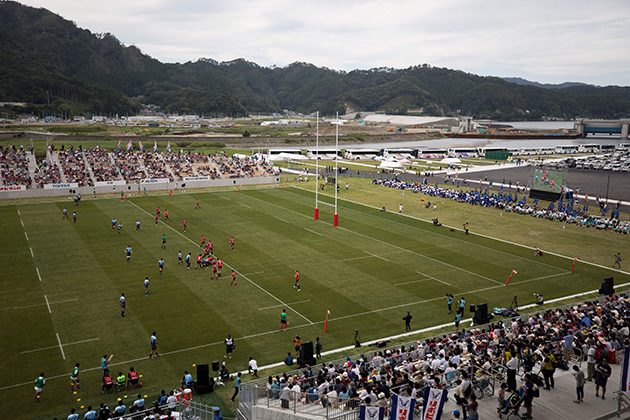Kamaishi was hit by the 2011 tsunami but next year will host two RWC 2019 games. Rich Freeman reports from the opening of the Kamaishi Unosumai Memorial Stadium
How Rugby World Cup 2019 is helping to rebuild Kamaishi
Back in 2007, Wallabies captain Stirling Mortlock described the Rugby World Cup as “not just a celebration of rugby but a celebration of the host nation”.
On 25 September 2019, when Fiji play Uruguay at Kamaishi Unosumai Memorial Stadium, you can add to that a celebration of a town’s bravery, resilience and gratitude.
On 11 March 2011, Kamaishi bore the full brunt of the tsunami that followed the Great Tohoku Earthquake.
The damage to the former iron hub turned fishing town was massive, with 1,064 of the town’s 39,400 citizens killed, 98% of the town’s fishing fleet destroyed, 60% of businesses flooded and 30% of buildings destroyed.
Yet rugby was never far from the locals’ minds – no huge surprise given the town was host for many years to Nippon Steel RFC, the “iron men from the north” who won seven straight All-Japan Rugby Football Championships between 1979 and 1985.

Ground force: The aerial view of Kamaishi Unosumai Memorial Stadium (Getty Images)
Players such as Pita Alatini and Scott Fardy refused to be airlifted out after the earthquake, opting to stay and help their team-mates and friends in the town. And just two months after the disaster Kamaishi Seawaves, who evolved when Nippon Steel closed their mines in the town, played Yamaha Jubilo in the hope it would give locals something to cheer about.
With Japan set to stage Rugby World Cup 2019, talk soon turned to whether the town could be a host city.
“Some people initially disagreed with the stadium build as there is still so much restructuring of housing to be done,” said Takeshi Nagata, a former scrum-half with the Seawaves and now an official with the Kamaishi City Rugby World Cup headquarters.
“But others saw it as being the creation of hope at a time when everyone was down and there was no hope in the city.”
MORE ON RUGBY WORLD CUP 2019
Rugby World Cup Fixtures 2023
The Rugby World Cup 2023 fixtures concluded with…
Rugby World Cup Groups
A rundown of the Rugby World Cup groups…
World Cup 2019 Venues
What you need to know about the 12…
Another former local favourite, Jiro Ishiyama, was a driving force behind the plan.
“I saw an almost flattened Kamaishi on TV and asked myself what I can do to help people out there,” said the former Japan prop who at the time worked for an affiliate of Nippon Steel in Shizuoka Prefecture, central Japan.
“I decided to do what I could do from outside Kamaishi for the time being so we could see Kamaishi picked as a host city of the World Cup.”
In March 2015, Ishiyama’s dream came true when Kamaishi was named one of the 12 venues.
Despite being a month shy of the corporate retirement age of 60, Ishiyama was one of the first to sign up as a construction worker when work on the new ground began in April 2017 and the stadium – complete with a state-of-the-art hybrid playing surface – was officially opened on 19 August 2019 with a match between Kamaishi Seawaves and Yamaha Jubilo.

Building work: Jiro Ishiyama poses in the new stadium (Getty Images)
Using seats made from wood that survived recent forest fires and others donated by Kumamoto Prefecture Athletic Stadium, the old National Stadium in Tokyo and Tokyo Dome, the current capacity is 6,000 but temporary stands will see it expanded to 16,000 when Fiji take on Uruguay and Namibia play the winner of the repechage on 13 October 2019.
“Kamaishi will be one of the great stories of Rugby World Cup 2019 and I am delighted that the tournament will help to bring this inspiring story of survival, resilience and reconstruction to the world,” said Akira Shimazu, the Rugby World Cup 2019 Organising Committee President and CEO.
While the fishing industry is nearly back to the levels of pre-March 2011, there are still around 1,100 people in temporary housing. But just about everyone in the town thinks the money spent on the stadium (around 3.9 billion yen/£27.3m) was money well spent.
“Before the disaster, having a lot of people coming here from overseas was something I couldn’t imagine,” said local hotel owner Akiko Iwasaki, who was washed away in the tsunami but survived after clinging to an upturned bus. “But thanks to rugby we have this opportunity.”

Centre field: Rui Horaguchi talks to the crowd before kick-off (Getty Images)
And the children who survived that fateful day, children that were at the two schools that were destroyed by the tsunami and on whose grounds the stadium now stands, want to make the most of the opportunity.
“I love rugby because in my second year of junior high school I watched my first game at the 2015 Rugby World Cup in England,” 16-year-old Rui Horaguchi told the crowd during a moving kick-off declaration. “I was overwhelmed with emotion by the power and atmosphere inside the stadium.”
Horaguchi said she wanted to give people the same hospitality she had been shown in England as a “friendship ambassador”. But most of all she said she wants to thank those in Japan “who love Kamaishi and everyone in the world who loves rugby… We have recovered and will move on forward. This stadium carries our gratitude and will set sail toward the future today.”
Follow Rugby World on Facebook, Twitter and Instagram.









